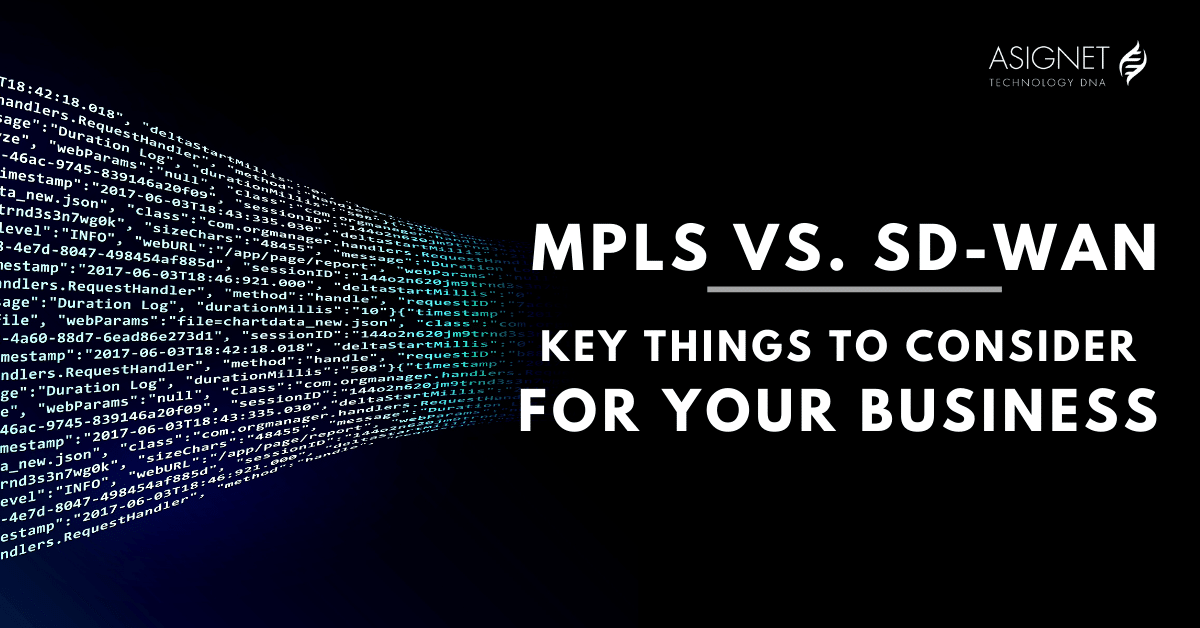The main difference between MLPS and SDWAN is that SDWAN can be managed entirely in the cloud in the most cost-effective and efficient manner.
When determining network performance, you need to consider factors affecting performance degradation and bandwidth exhaustion on your network and how that is impacting traffic on your network and ultimately your business.
These types of issues should lead the network manager to consider how these issues may be alleviated by utilizing smarter network management solutions.
So, let us consider some of the factors that can drive the decision of if and when it makes sense to make the switch from MPLS to SD-WAN.
Multi-Protocol Label Switching (MPLS) is a very mature service provider technology connecting private sites, branch-size networks, or public cloud into private networks, using any mainstream data transmission protocol. Before the advent of cloud infrastructure and services, these were fixed connections running from the provider to an enterprise or hosted MPLS switch. With the proliferation of cloud services, these now typically connect to the enterprise via a private or hybrid cloud.
One major advantage of MPLS is that it is a very secure and robust connection type. In addition to providing transport If provided by a carrier, it would typically include service assurances and service level agreements.
Running as a secure private tunnel within the provider’s secured network, it is much like a multi-protocol VPN that connects discreet network points, providing the advantages of old transport technologies such as Frame and ATM without the overhead baggage, but retaining the traffic engineering features they provided
However, MPLS has some disadvantages
- It is bandwidth-intensive in that it must traverse a defined path to move its payload from point to point, more suitable to older more traditional environments where enterprises bought large data pipes and traffic moved discreetly between defined paths.It is less suitable for the types of dynamic networks in use today were depending on not only the size but type of traffic, packets are more sensitive to QOS issues.For example, with the growth of UCaaS, dynamic video conferencing is the norm and that type of connection has zero-tolerance for bandwidth contention. Today’s networks demand a dynamically managed network with the intelligence to make smart decisions based on a multitude of different factors that may vary from transaction to transaction type.
- A second major disadvantage is that traditional MPLS networks were built with a hub and spoke design requiring all traffic to be backhauled to the data center hub to be processed and re-distributed to the intended end-point.This is very inefficient and much more bandwidth-intensive and again creates latency that is not well tolerated or acceptable in today’s distributed connection models.
- Thirdly, MPLS does not do any sort of data analysis of the data packet itself, instead, it is using just the labels for instructions on where next to send it to. So the security of the packet itself is still dependent on client-side firewalls or other protocols to interrogate or analyze the packet itself.This means that without effective client controls, malware can be distributed very easily throughout the network as MPLS routes it from one point to the next.
Enter SD-WAN
SD-WAN provides superior network agility and reduces costs compared to traditional WAN infrastructure.
Managed properly, it vastly increases connection flexibility whilst retaining and enhancing the security of data. It provides an any-point to any-point fully meshed connectivity matrix with the ability to intelligently route traffic via different paths bases on QoS and security requirements and policy, bandwidth availability, traffic load, etc. It basically adds a software layer between transport and application for intelligent traffic engineering options.
The single major difference of SD-WAN over traditional WAN or MPLS infrastructure is that the WAN can be managed entirely in the cloud. This means that no matter where an application is hosted; on-site, public/private/hybrid cloud, or connected by a SaaS provider (think Salesforce, Concur, O365, AWS, etc.), SD-WAN provides the intelligence to manage the connectivity in the most cost-effective and efficient manner.
This compares very favorably to a traditional WAN architecture where all traffic had to be backhauled to a central data center location for security and routing, resulting in much higher costs in-circuit costs, as well as significant productivity and connectivity issues caused by traffic congestion.
Choosing an SD-WAN service is also important because these range from basic to a more robust business-class solution.
The difference lies in the amount and types of intelligent and security controls that are used to manage the connectivity and transport of data from endpoint to endpoint. This allows for handling things such as almost instantaneous switchover to alternate paths in the event of a primary path failure, touchless provisioning simultaneously to all nodes for things like security patches or upgrading policies, etc.
So what are the main drivers behind why enterprises are rapidly adopting the use of SD-WAN over traditional MPLS?
- MPLS infrastructure is expensive. SD-WAN is more affordable and used off-the-shelf components for the most part.
- SD-WAN is highly flexible and provides intelligent traffic routing. MPLS must be backhauled for re-distribution to the next leg and may involve multiple hops to reach the final destination which increases latency and traffic congestion.
- SD-WAN offers built-in security capabilities. MPLS does not analyze the security of the packet, just looking at the header to determine where to route.
- SD-WAN is much more cost-effective and flexible. MPLS requires much more bandwidth because of backhauling, is a discrete node to node routing mechanism, and offers no security or intelligent failover options.
How Asignet brings value and cost savings to enterprises using MPLS or SD-WAN or considering the switch to SD-WAN
Asignet provides a proprietary cloud-based aPaaS platform – Wayfast (www.wayfast.com), that provides the architectural backbone of a set of highly flexible solutions that are currently backed by 11 global patents and provides a single comprehensive platform that seamlessly and dynamically ties all aspects of IT assets, usage and cost into one holistic view.
Built as a rapid application development (RAD), low-code development platform, Asignet is the only provider that fully integrates robotic process automation (RPA) as the technological means to easily build and deploy thousands of workflows to drive thousands of automated activities, integrating with any other system and making intelligent decisions or executing intelligent actions based on an analysis of the data being collected. Offering a full suite of highly configurable ITAM, ITSM, UCaaS, and a full suite of technology expense management (TEM) solutions and services.
Benefits of using Asignet in an MPLS/SD-WAN environment:
With a comprehensive and fully integrated suite of IT management and control capabilities, Asignet through its Wayfast platform and native RPA processes can provide a layer of audit, visibility, BI, and savings through its capability to integrate and analyze disparate data.
What networks do NOT do from a management perspective is to audit and validate that the usage and any equipment that the client has rented or leased is compliant with the rates that were contracted for and further, that the billing received from the provider of these services accurately reflects any assets in use and is contract compliant and contains no billing errors.
Asignet can provide these solutions, among many others to meet these needs:
- Building and auditing an accurate baseline of all network inventory. This can include managing audit claims for any refunds that may be due, but more importantly, creating an accurate baseline of IT assets.Asignet has a comprehensive and proprietary way to discover load and validate inventory information from providers and other sources. An accurate inventory is also critical for clients considering – or in the process of – migrating to SD-WAN.
- Discovery of all nodes and endpoints and usage at each. Asignet can use a passive client to determine all active/inactive endpoints and analyze traffic patterns for each connection point and identify where there is under/over utilization or other operational inefficiencies.
- Turning down old lines and circuits post-migration. It is not uncommon that old lines of services were never disconnected during a transition project. Recovery of past amounts paid is sometimes possible.
- Management of all equipment by location and maintenance. It is not uncommon – especially for a client doing a migration to a different network – that equipment under maintenance is taken out of service but the maintenance is never canceled, resulting in significant cost for gear no longer being used.This also helps in the analysis and determination of where it makes financial sense to renew or replace gear that is at end of contract, based on ongoing manufacturer support, end of life, more efficient replacement options, etc.
- Using proprietary processes, ensure that not only is the inventory accurate, but that it is contractually compliant. Cloud services are billed very differently than traditional data services and the billing for these are more complex.Asignet has defined processes to validate that the contracted rate for the type of service being used is correct and that the billing is accurate based on usage as well as per contract.
- Automated workflows to provide notification or automatically initiate action based on defined business rules for a defined state or condition.
- Holistic BI reporting tying together all attributes – from inventory to usage to billing and location, presents the enterprise with intelligent actionable data that will help to drive better decision making based on hard data and not guesswork.






